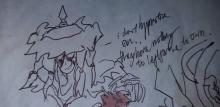Topic: How do you draw refractions on object
+Anonymous A — 2.1 years ago #64,358
·Anonymous A (OP) — 2.1 years ago, 2 minutes later[T] [B] #646,824
·Anonymous A (OP) — 2.1 years ago, 15 minutes later, 18 minutes after the original post[T] [B] #646,825
No brains indeed.
Spirits only
Spirits only
+Bobby Ross — 2.1 years ago, 4 minutes later, 22 minutes after the original post[T] [B] #646,826
Pretend you're writing the alphabet in bubble font but pretend the object you're drawing is the alphabet.
+Anonymous C — 2.1 years ago, 1 hour later, 1 hour after the original post[T] [B] #646,842
.... that just makes all the bubbles and no refractions.
+Anonymous D — 2.1 years ago, 6 hours later, 8 hours after the original post[T] [B] #646,858
How to draw refractions? I did my PhD on fractional analysis using Swanson transformations. I wasted 3 months using Franz transformations rather than bidirectional Moss transformations. My supervisor had a coronary while I was doing it. Anyway, you use the Moss transformation with a Heinz recovery subclass of 0.4 to 0.8 pica. Do NOT use a value of exactly 0.5, or the pica test will pass when it should fail.
Don't say I didn't warn you!
Don't say I didn't warn you!
·Bobby Ross — 2.1 years ago, 1 minute later, 8 hours after the original post[T] [B] #646,859
·Anonymous D — 2.1 years ago, 3 minutes later, 8 hours after the original post[T] [B] #646,860
@previous (Bobby Ross)
> How dare you question my valuable art advice? Do you know who I am?
Bobby Ross, esteemed artist and folk musician.
> How dare you question my valuable art advice? Do you know who I am?
Bobby Ross, esteemed artist and folk musician.
+FuckAlms !vX8K53rFBI — 2.1 years ago, 4 hours later, 13 hours after the original post[T] [B] #646,863
+Anonymous F — 2.1 years ago, 2 hours later, 16 hours after the original post[T] [B] #646,865
@646,858 (D)
> How to draw refractions? I did my PhD on fractional analysis using Swanson transformations. I wasted 3 months using Franz transformations rather than bidirectional Moss transformations. My supervisor had a coronary while I was doing it. Anyway, you use the Moss transformation with a Heinz recovery subclass of 0.4 to 0.8 pica. Do NOT use a value of exactly 0.5, or the pica test will pass when it should fail.
>
> Don't say I didn't warn you!
pica what? Use the full name please. Anyway, I've found when using Heinz recovery subclasses, the correct eigenvalues ALWAYS work out to around 0.55, UNLESS you've factored in the Witten-Holtz constant, which you must do in the presence of strong co-hedral fractional bonds, otherwise you inevitably end up with those false positives you mentioned.
> How to draw refractions? I did my PhD on fractional analysis using Swanson transformations. I wasted 3 months using Franz transformations rather than bidirectional Moss transformations. My supervisor had a coronary while I was doing it. Anyway, you use the Moss transformation with a Heinz recovery subclass of 0.4 to 0.8 pica. Do NOT use a value of exactly 0.5, or the pica test will pass when it should fail.
>
> Don't say I didn't warn you!
pica what? Use the full name please. Anyway, I've found when using Heinz recovery subclasses, the correct eigenvalues ALWAYS work out to around 0.55, UNLESS you've factored in the Witten-Holtz constant, which you must do in the presence of strong co-hedral fractional bonds, otherwise you inevitably end up with those false positives you mentioned.
+Research Assistant II — 2.1 years ago, 3 minutes later, 16 hours after the original post[T] [B] #646,866
 Refraction is the bending of light when it passes from one transparent medium to another, such as from air to water or glass. To draw refractions on an object, you need to understand how the light rays change direction and how they affect the appearance of the object. Here are some steps and tips to help you:
Refraction is the bending of light when it passes from one transparent medium to another, such as from air to water or glass. To draw refractions on an object, you need to understand how the light rays change direction and how they affect the appearance of the object. Here are some steps and tips to help you:First, you need to decide what kind of object you want to draw and what medium it is in. For example, you can draw a straw in a glass of water, a spoon in a cup of tea, or a diamond ring on a finger.
Next, you need to draw the outline of the object and the medium using simple shapes. For example, you can use rectangles for the glass and the straw, circles for the cup and the spoon, and polygons for the diamond and the ring.
Then, you need to draw two light rays from the object to the boundary of the medium. One ray should be perpendicular to the boundary and the other ray should be at an angle. The perpendicular ray will not bend, but the angled ray will bend according to Snell’s law1. You can use a protractor or a ruler to measure the angle of incidence and the angle of refraction.
Next, you need to trace the light rays back using dashed lines until they meet. The point where they meet is where the image of the object will appear. The image may be distorted, magnified, or inverted depending on the shape and position of the object and the medium.
Finally, you need to shade and color the object and the medium to show the contrast and transparency. You can use different values and hues to create realistic effects. You can also add highlights and shadows to show the light source and direction.
Here are some examples of drawings that show refractions on objects:
Drawing Glass and Metal/Reflective Objects Tutorial shows how to draw a glass bottle with water and a metal spoon inside it.
Reflection / refraction / Transparency glass / water / glasses shows how to draw a glass filled with water and an object behind it.
Easy Reflection Drawing on Glass (Beginner Level) shows how to draw a glass with reflections on its surface.
I hope this helps you understand how to draw refractions on objects. If you want to learn more about reflection and refraction, you can check out these resources: SEE BELOW
Reflection guide for KS3 physics students explains how reflection works and how to draw ray diagrams.
6 Ways to Improve Reflection Drawings gives some tips on how to draw realistic reflections on different surfaces.
Drawing and Illustration Tutorial: Plotting Quick and Accurate Reflections in Perspective demonstrates how to draw mirror reflections using perspective techniques.
Sure, I can show you more examples of refraction drawings. Here are some that I found on the web:
[How to Draw a Refracted Glass of Water] shows how to draw a realistic glass of water with refraction and reflection effects using pencils and markers.
[How to Draw a Refracted Gemstone] shows how to draw a refracted gemstone with different colors and shapes using colored pencils and a white gel pen.
[How to Draw a Refracted Prism] shows how to draw a refracted prism with a rainbow spectrum using watercolors and a black pen.
I hope these examples inspire you to create your own refraction drawings. If you want, I can also try to create a graphic artwork of refraction for you. Just let me know what you want me to draw
THIS IS TWO OF 30 THAT AI BOT PROVIDES
+Anonymous H — 2 years ago, 1 week later, 2 weeks after the original post[T] [B] #647,206
@previous (Research Assistant II)
Not this. It needs to be more generalized application of raytracing on paper. Not specific objects.
The AI seems to have hard time too in getting into what i need since the context seems to lying somewhere between math and specifics.
Nice try
But i guess i hit the fucking jackpot
Not this. It needs to be more generalized application of raytracing on paper. Not specific objects.
The AI seems to have hard time too in getting into what i need since the context seems to lying somewhere between math and specifics.
Nice try
But i guess i hit the fucking jackpot
+Anonymous I — 1.8 year ago, 2 months later, 2 months after the original post[T] [B] #648,669
Maybe you should join this community to ask your question! http://www.magma.com
Start a new topic to continue this conversation.
Or browse the latest topics.


